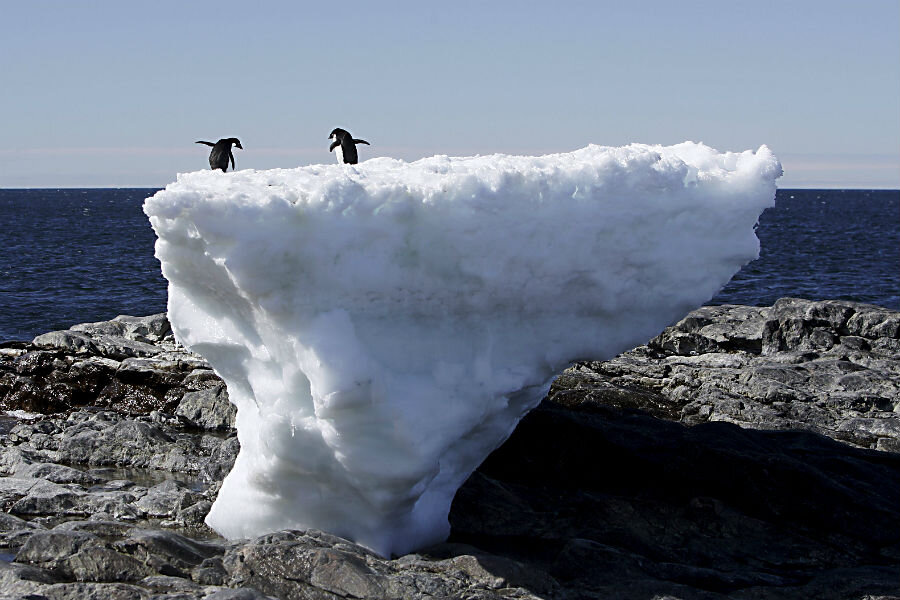Antarctic carbon dioxide reaches highest levels in 4 million years
Loading...
Antarctica recently witnessed an event that last took place four million years ago: Carbon dioxide levels broke through the barrier of 400 parts per million (ppm).
In fact, the frozen continent is a laggard in this respect. The announcement Wednesday by the National Oceanic and Atmospheric Administration (NOAA) gave the date of this milestone as May 23. But the global annual mean concentration of carbon dioxide already surpassed 400 ppm last year, the first time that has happened in human history.
While the number 400 does not hold any inherent significance, it has become something of a symbol as more of the world becomes convinced of the need to stop the ballooning levels of carbon dioxide in our atmosphere.
“The far southern hemisphere was the last place on earth where CO2 had not yet reached this mark,” said Pieter Tans, lead scientist of NOAA's Global Greenhouse Gas Reference Network, in the agency’s press release. “Global CO2 levels will not return to values below 400 ppm in our lifetimes, and almost certainly for much longer.”
NOAA’s announcement comes hot on the heels of a paper in Nature, published Monday, in which the authors described not only 2015’s record-breaking global mean carbon dioxide concentration, but also predicted that 2016 would see no monthly global mean drop below the iconic 400 ppm mark.
But there is special significance in seeing this barrier breached at the south pole. While all parts of the globe are experiencing boosted levels of atmospheric carbon dioxide, Antarctica’s remote location and its consequent isolation from human industry have given it a certain level of insulation.
It is the final frontier to feel the effects of fossil fuel consumption, the primary driver of greenhouse gas pollution, of which carbon dioxide constitutes 65 percent.
Levels of carbon dioxide fluctuate throughout the year, as plants absorb more during the growing season, to fuel photosynthesis. But the number of plants covering the globe is inadequate to absorb all of the emissions – and the quantity of forest cover is only diminishing, destroyed at a rate equivalent to 48 football fields every minute.
Each year since monitoring began in 1958, the amount of carbon dioxide in the atmosphere has risen. And last year, the annual jump in carbon dioxide was the highest ever recorded, leaping up by more than 3 ppm.
The statistics paint a grim picture, but the world is stirring into action, as illustrated by the Paris climate deal, formally signed by more than 170 nations in New York earlier this year.
“Where some past efforts to address global warming were marked by bickering and the search for grand bargains,” wrote The Christian Science Monitor’s Mark Trumbull after the signing, “the agreement reached four months ago in Paris was about pragmatism and nudges. Aspiration met the art of the possible.”
And, as a 2015 Pew Research Center report revealed, there is substantial global support for a reduction in greenhouse gas emissions. In the United States, even though there is still a stark difference between the attitudes of Democrats and Republicans, the cross-party average reflects 72 percent in favor of limiting emissions.
In a very concrete example of how science is contributing to the fight against climate change, researchers in Iceland recently succeeded in turning carbon dioxide to stone in the space of two years, an astounding feat when compared with predictions of the Intergovernmental Panel on Climate Change (IPCC), which estimated the process would take between 100 to 1,000 years.
Yet the promise of such carbon capture and storage techniques addresses a symptom, rather than the cause, and there can be no substitute for the reduction of greenhouse gas emissions, say scientists.
“In the longer term, a reduction in CO2 concentration would require substantial and sustained cuts in anthropogenic emissions to near zero,” write the authors of the recent Nature paper. “Even the lowest emissions/concentrations scenario assessed in the IPCC Fifth Assessment Report projects CO2 concentrations to remain above 400 ppm until 2150.”








